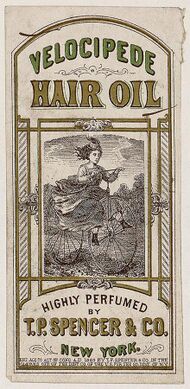Chemistry:Hair oil
Hair oil is an oil-based cosmetic product intended to improve the condition of hair. Various types of oils may be included in hair oil products. These often purport to aid with hair growth, dryness, or damage.[1][2]
History
Ancient Egyptians paid special attention to hair and images of hairdressers are depicted in ancient relics found by archaeologists. Archaic texts found during this era had information about “recipes” used by the Egyptians to tackle baldness. During this time period people used combs and ointments to groom and style their hair.[3]
Uses
Many cosmetic products including shampoo, heat protectant, hair drops, or hair masks contain oils.[citation needed]
Humans produce natural hair oil called sebum from glands around each follicle. Other mammals produce similar oils such as lanolin. Similar to natural oils, artificial hair oils can decrease scalp dryness by forming hydrophobic films that decrease transepidermal water loss, reducing evaporation of water from the skin.[4] Oils on the hair can reduce the absorption of water that damages hair strands through repeated hygral stress as hair swells when wet, then shrinks as it dries.[5] Oils also protect cuticle cells in the hair follicle and prevent the penetration of substances like surfactants.[5] Saturated and monounsaturated oils diffuse into hair better than polyunsaturated ones.[6]
Oil types
Mineral and vegetable oils are used to make a variety of commercial and traditional hair oils. Coconut oil is a common ingredient. Other vegetable sources include almond, argan, babassu, burdock, Castor, and tea seed.[citation needed]
Natural oils are used more commonly as cosmetic products on the scalp. Natural oils come from natural resources that are very high in nutrients such as vitamins and fatty acids.[7][better source needed]
Coconut oil
Coconut oil has properties that reduce protein loss in hair when used before and after wash.[8] Coconut oil is known to have lauric acid, which is a type of fatty acid that may penetrate the hair shaft due to a low molecular weight and linear conformation.[9]
Argan oil
Argan oil originates from Morocco and is known for a conditioning effect that leaves hair soft and relieves frizz.[citation needed]
Avocado oil
Avocado oil is rich in nutrients. It has a high concentration of vitamin E, which is an antioxidant that may decrease hair loss and encourages hair growth.[10][irrelevant citation]
Other oils
Oils including almond oil, grapeseed oil, jojoba oil, olive oil may promote hair elasticity and help prevent dryness and hair damage.[4]
See also
- Beard oil
- Pomade
- Shaving oil
References
- ↑ "Scientists validate more herbs for hair growth" (in en-US). 2019-04-18. https://guardian.ng/features/scientists-validate-more-herbs-for-hair-growth/.
- ↑ Barve, Kalyani; Dighe, Apurva (2016), Barve, Kalyani; Dighe, Apurva, eds., "Hair Oils" (in en), The Chemistry and Applications of Sustainable Natural Hair Products, SpringerBriefs in Molecular Science (Cham: Springer International Publishing): pp. 5–24, doi:10.1007/978-3-319-29419-3_2, ISBN 978-3-319-29419-3, https://doi.org/10.1007/978-3-319-29419-3_2, retrieved 2021-11-27
- ↑ Sherrow, Victoria (2006). Encyclopedia of hair : a cultural history. Westport, Conn.: Greenwood Press. ISBN 0-313-33145-6. OCLC 61169697. https://www.worldcat.org/oclc/61169697.
- ↑ 4.0 4.1 Mank, Valerii; Polonska, Tetyana (June 2016). "Use of natural oils as bioactive ingredients of cosmetic product's". Ukrainian Food Journal 5 (2): 281–289. doi:10.24263/2304-974x-2016-5-2-7. ISSN 2304-974X.
- ↑ 5.0 5.1 Gavazzoni Dias, Maria FernandaReis (2015). "Hair cosmetics: An overview" (in en). International Journal of Trichology 7 (1): 2–15. doi:10.4103/0974-7753.153450. ISSN 0974-7753. PMID 25878443.
- ↑ Robbins, Clarence (2012). Chemical and Physical Behavior of Human Hair, 5th Edition. New York: Springer. ISBN 978-3-642-25611-0.
- ↑ Hajini, G.H.; Kandhari, K.C.; Mohapatra, L.N.; Bhutani, L.K. (1970-11-01). "Effect of hair oils and fatty acids on the growth of dermatophytes and their In vitro penetration of human scalp hair". Sabouraudia 8 (3): 174–176. doi:10.1080/00362177085190851. ISSN 0036-2174. PMID 5496803. https://doi.org/10.1080/00362177085190851.
- ↑ Rele, Aarti; Mohile, R B (2003). "Effect of mineral oil, sunflower oil, and coconut oil on prevention of hair damage". J Cosmet Sci 54 (2): 175–192. PMID 12715094. https://pubmed.ncbi.nlm.nih.gov/12715094/.
- ↑ Reis, Maria; Dias, Gavazzoni (2015-03-18). "Hair cosmetics: An overview". International Journal of Trichology 7 (1): 2–15. doi:10.4103/0974-7753.153450. PMID 25878443.
- ↑ Dreher, Mark L.; Davenport, Adrienne J. (January 2013). "Hass Avocado Composition and Potential Health Effects". Critical Reviews in Food Science and Nutrition 53 (7): 738–750. doi:10.1080/10408398.2011.556759. ISSN 1040-8398. PMID 23638933.
 |


